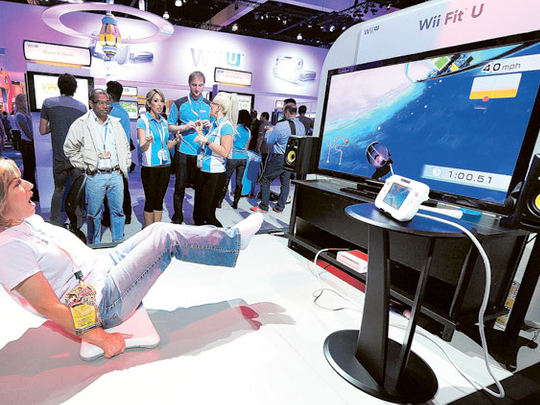
Los Angeles: If the gaming industry agreed on one idea at this week’s Electronic Entertainment Expo, it’s that playing video games on just one screen is no longer enough.
The top three publishers — Microsoft, Nintendo and Sony — each focused on new ways to spread games and other content across several screens at the gaming industry’s annual trade show in downtown Los Angeles.
While the publishers’ systems rely on the same premise, namely using more screens to access more content, each is achieving multi-screen functionality through different means: Microsoft is tapping into existing phones and tablets” Sony is depending on its PlayStation Vita handheld device” and Nintendo is coupling an iPad-like controller with its new Wii U console.
“I don’t know who has the best approach,” said Martin Rae, president of the Academy of Interactive Arts and Sciences.
“I kind of like Microsoft’s at this point, but it’s going to be whatever is easiest, and then I think they’ll all get it right.”
Microsoft surprised E3 attendees Monday by unveiling software called Xbox SmartGlass that will allow Xbox 360 users to stream content to their smartphones, tablets and PCs.
The app was demonstrated through such actions as turning a smartphone into a remote used to browse the web and transforming a tablet into a map for the new game Ascend: New Gods.
“I think you’re going to see these persistent entertainment experiences show up all the time,” said Phil Spencer, corporate vice-president of Microsoft Game Studios.
“You’re really going to start blurring where I’m playing to what I’m playing.”
Sony continued to build upon the “cross-play” functionality of its PlayStation 3 console and high-definition Vita handheld device.
In one example on the E3 show floor with the platform game LittleBigPlanet 2, one player tapped the Vita screen to drop eggs into the tops of chutes, while two other players tried catching them below on the TV using PS3 remotes.
“The future of gaming is something like PlayStation All-Stars: Battle Royale, where you’re playing against people all over the world, and some people are playing on a Vita and some people are playing on a PlayStation,” said Jack Tretton, president of Sony Computer Entertainment of America, of the new fighting game that will be available for online play across both systems.
Nintendo is taking a decidedly different route when it comes to multiple screens.
The company unleashed several games at E3 for its new Wii U console, which uses a 6.2-inch touchscreen controller to provide different perspectives and gameplay compared to what’s on TV. It can also be used independent of the TV, but it’s not portable like the Nintendo 3DS.
“It’s not a separate purchase,” said Reggie Fils-Aime, president of Nintendo of America.
“It’s an integrated part of the overall system, and what that means is the gameplay and experiences you’ll have are much more continuous and holistic.”
New Super Mario Bros U and NintendoLand best illustrated what Nintendo is calling “asymmetric gameplay,” different experiences for Wii U GamePad users than those playing with regular Wii Remotes, while third-person action titles Assassin’s Creed III and Batman: Arkham City leveraged the touchscreen controller as a way to display additional information.
The game that seemed to win the most acclaim with expo-goers for its use of a second screen was Ubisoft Entertainment’s ZombiU, a first-person Wii U zombie game that transforms the gyroscope-equipped controller’s screen into a virtual scanner that can find items, hack electronic locks and zoom in on the undead when it’s moved around in the real world.
Parenting several children
Now that the hardware and software has been hyped to the world at the gaming industry’s biggest extravaganza, it’s up to game developers to craft compelling ways to use more than one screen.
Rod Fergusson, director of production at Gears of War developer Epic Games, likened the rigours of making game content for multiple screens to parenting several children.
“If I have one child, then it gets 100 per cent of my attention,” Fergusson said.
“If I have two children, then they get 50 per cent. If I have three children, they get 33 per cent. That’s the same way with game features. The more features you have in a game, the more divided your attention, and the harder it is to take it to the level you want to take it.”
Publishers, already spurred by the popularity of cheaper-to-produce mobile and social games, were coy on when these new systems would be released and how much they’d cost.
Nintendo didn’t reveal a price or release date for the Wii U beyond the holiday season, and Microsoft said SmartGlass would be free and out sometime this fall.
There’s at least one person who’s already come out against this multi-screen revolution: Snoop Dogg.
“As far as having four or five different screens and watching this and that at the same time, it’s confusing,” said the rapper, who was on hand at developer Namco Bandai’s booth on Tuesday to promote his appearance in the Tekken Tag Tournament 2 fighting game.
“I only got one brain and two eyes.”










